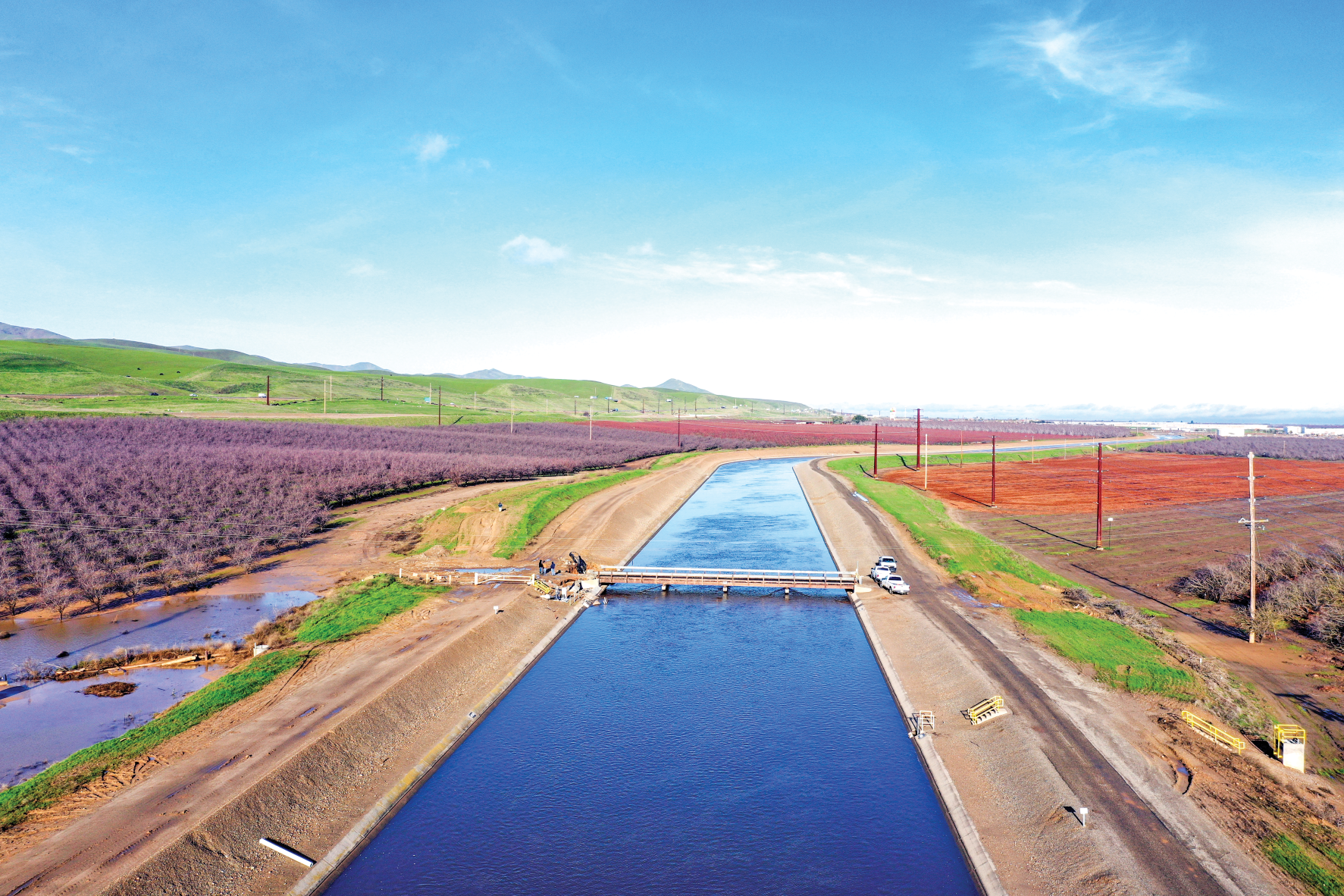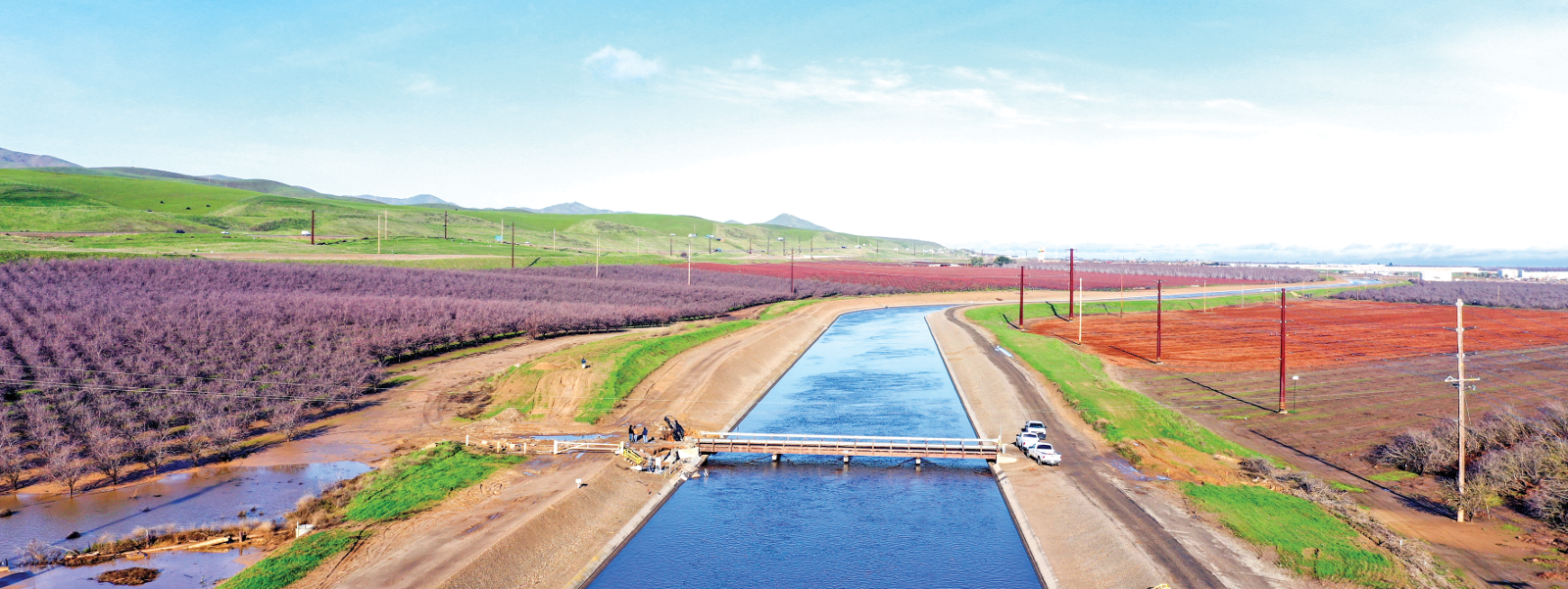State water board weighs status of six aquifer plans

Photo/Courtesy of Jarrett Martin
Local agencies in the San Joaquin Valley’s Delta-Mendota subbasin, which features the Delta-Mendota Canal, are working to fix deficiencies in state-mandated plans to bring groundwater supplies into balance within 20 years. The basin is one of six under scrutiny by state water officials.

By Christine Souza
Local agencies for six San Joaquin Valley subbasins, facing possible state intervention after their groundwater sustainability plans were deemed inadequate, learned more about next steps last week from California water officials.
During a board meeting of the California State Water Resources Control Board, officials signaled a willingness to allow agencies to bring aquifer plans into compliance with state sustainability mandates.
“The board’s role is intended to be temporary, so state intervention is not a replacement for a groundwater sustainability plan,” said Natalie Stork, state water board supervising engineering geologist of the groundwater management program. “Our goal is to help get basins back on track with DWR (California Department of Water Resources), so it’s a temporary process.”
The water board took no action on the issue but heard from staff about ways it could intervene in addressing inadequacy determinations for six rejected plans. They include plans for Chowchilla subbasin, Delta-Mendota subbasin, Kaweah subbasin, Kern County subbasin, Tulare Lake subbasin and Tule subbasin.
Under the 2014 Sustainable Groundwater Management Act, the state intervention process begins with a determination by the board as to whether inadequacies identified by DWR warrant placing the basin in probationary status. The board makes its basin designations through a public process that includes notice and a public hearing.
SGMA requires local agencies to adopt sustainability plans for high-priority and medium-priority groundwater basins. Local agencies must report annually and meet five-year milestones to bring aquifers into balance within 20 years.
State officials said the six plans were missing information that the state needs to determine compliance. The plans must show a roadmap for how groundwater basins will achieve long-term sustainability by limiting overdraft, land subsidence and impacts to drinking water.
Local groundwater sustainability plans, or GSAs, must implement near-term actions, such as expanding monitoring programs, reporting annually on groundwater conditions, implementing aquifer recharge projects and designing allocation programs. Once plans are implemented locally, measures must continue even if basins are under state intervention.
“With all of the deadlines that have come in on SGMA, agencies by and large have hit every deadline, which I think is a remarkable feat,” said Paul Gosselin, deputy director of DWR’s Sustainable Groundwater Management Office. “These are not easy plans to develop and work on, especially when there’s a lot of uncertainty and data gaps, which are in every basin.”
Staff from the water board and DWR discussed the state intervention process by the board, which has the authority to step in to manage a basin if necessary. Stork explained that the board decides whether a probationary hearing is warranted. If so, a notice of a public hearing is issued and cities, counties and well owners are contacted. In the meantime, she said, the board collects data and fees while agencies work to fix deficiencies.
“When the board puts a basin on probation, it must identify deficiencies and actions to remedy those deficiencies,” Stork said, adding that GSAs have time to address issues and continue to implement their plans during probation. “Any basin put on probation would have a minimum of one year before the board could (give) notice for the adoption of an interim plan.”
One of the basins under scrutiny, the Delta-Mendota subbasin, spans six counties and has 23 groundwater sustainability agencies.
“We’re fully committed to getting a groundwater sustainability plan that is not only adequate but that addresses sustainability into the future for our communities, our ecosystems, our farmers and our businesses,” said Jarrett Martin, chair of the Delta-Mendota subbasin and general manager of the Central California Irrigation District.
“We do have a long history in our subbasin of working together, and with time, we will address these deficiencies,” Martin said. “We’ve gone back to the drawing board, and we’re taking some honest criticism from DWR and making it a strong point for us to be very progressive and very active to get those deficiencies fixed.”
Justin Fredrickson, California Farm Bureau environmental policy analyst, told the board he is encouraged by its “repeated restatement of the board’s goal, recognizing that this (intervention) is a temporary process.”
“Hopefully, state intervention in these various basins can be narrowly tailored and can build on the existing plans and work that has been done to date, and can line up as much as possible, so that we’re not wasting expense,” Fredrickson said. “The board and the state really need to be working together with the locals to get this right over the next 20 years.”
For agencies put on probation, the board and staff discussed ways to get them back on the path to groundwater sustainability, including by requiring meters on wells for more accurate extraction data.
Matt Zidar, water resources manager for San Joaquin County, told the board that metering is not required under the statute. “It is going to be up to the state board to make some determinations based on good engineering evidence and science in terms of what would be appropriate,” he said.
“Metering isn’t the only thing, and I get worried that when that is perceived as the hammer that is available to you, you are going to find that everything you encounter is going to need pounding, so I’d counsel on taking a look a little deeper beyond that,” Zidar added. “I think we can accomplish the same ends in terms of accurate volumetric reporting without requiring a meter.”
Related to intervention, the board decided to meet again in two months to discuss the issue.
E. Joaquin Esquivel, chair of the state water board, said, “There’s been an incredible amount of progress actually that has been made.”
“We need everyone to take these issues as seriously as I know everyone feels them to be, given how intense the drought has been these last years and how impactful they’ve been to so many of our communities,” he said.
Of a total 94 groundwater basins required to submit plans under SGMA, state water officials in March provided determinations for 24 basins and is reviewing an additional 61 plans from 59 California high- and medium-priority basins submitted to DWR in January 2022. DWR said it anticipates issuing determinations for the remaining basins throughout 2023.
(Christine Souza is an assistant editor of Ag Alert. She may be contacted at csouza@cfbf.com.)




